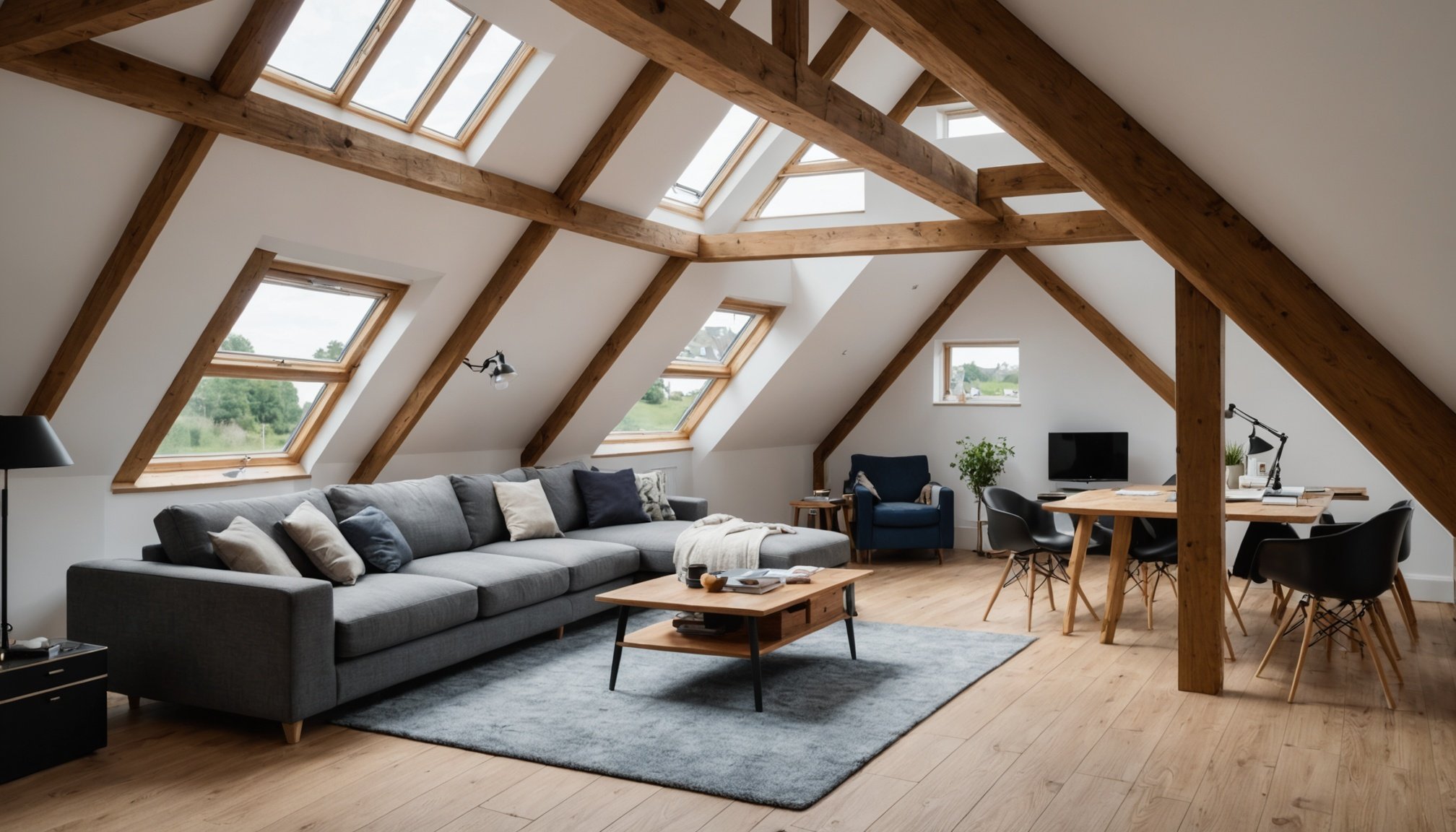Unlocking Your Loft: Essential Legal Guidelines for Loft Conversions in Birmingham
Understanding the Basics of Loft Conversions
When considering a loft conversion in Birmingham, it’s crucial to start with a clear understanding of what the project entails and the legal framework that governs it. A loft conversion is a great way to add living space to your home without the need for a full-scale extension. However, it involves more than just adding a few beams and some insulation; it requires careful planning, compliance with regulations, and often, the involvement of local authorities.
Why Choose a Loft Conversion?
Loft conversions offer several benefits, including the potential to increase the value of your property, provide additional living space, and enhance the overall aesthetic of your home. Here are a few reasons why homeowners in Birmingham might opt for a loft conversion:
A voir aussi : Effective Strategies to Ward Off Bathroom Mold in Windowless UK Spaces
- Increased Living Space: A loft conversion can turn an underutilized area into a functional room, such as a bedroom, office, or even a luxurious bathroom.
- Cost-Effective: Compared to moving to a larger home or building an extension, loft conversions can be more cost-effective.
- Environmental Benefits: By utilizing existing space, you reduce the need for new building materials and minimize the environmental impact.
Planning Permission: What You Need to Know
Before you begin your loft conversion project, you need to determine whether you require planning permission. In Birmingham, as in many other parts of the UK, the rules can be complex.
Permitted Development Rights
Under the Permitted Development Rights, certain loft conversions do not require planning permission. However, there are strict criteria to meet:
A voir aussi : Blending Timeless Tradition with Contemporary Style: A Guide to Restoring Your Tudor Home in Suffolk
- Volume Limitations: The conversion must not exceed 50 cubic meters for detached and semi-detached houses, and 40 cubic meters for terraced houses[4].
- Design Restrictions: The conversion should be similar in appearance to the existing house and not extend beyond the plane of the existing roof slope[4].
- Neighborhood Considerations: The conversion should not overlook neighboring properties or cause significant disturbance.
When Planning Permission is Required
Despite these permitted development rights, there are scenarios where planning permission is necessary:
- Dormer Extensions: If your design includes a dormer extension, especially one that faces the road, you are likely to need planning permission[3].
- Conservation Areas: If your property is located in a conservation area or is a listed building, you will need to obtain planning permission for any loft conversion.
- Party Wall Agreements: While not strictly planning permission, you may need to serve a party wall notice to your neighbors if the conversion affects a shared wall.
Building Regulations: Ensuring Safety and Quality
Building regulations are a critical aspect of any loft conversion project. These regulations ensure that your new space is safe, energy-efficient, and meets the standards of a newly built dwelling.
Key Building Regulations
Here are some key building regulations you need to comply with:
- Structural Stability: The building must be assessed for structural stability to ensure it can support the additional weight of the conversion[1].
- Energy Efficiency: SAP calculations are required to design the energy efficiency of the home, including insulation and heating performance[1].
- Sound Testing: Sound testing is required on completion, and all construction elements affecting sound must be detailed and built in accordance with approved plans[1].
- Fire Safety: The conversion must comply with fire safety regulations, including the installation of smoke alarms and ensuring escape routes are clear[1].
Approved Documents
Building regulations are detailed in various approved documents, each covering a different aspect of the build:
| Approved Document | Description |
|---|---|
| Part A – Structure | Ensures the building is structurally sound[1] |
| Part B – Fire Safety | Covers fire safety measures, including escape routes and fire alarms[1] |
| Part C – Site Preparation | Deals with resistance to contaminants and moisture[1] |
| Part E – Resistance to the Passage of Sound | Ensures the building meets sound insulation standards[1] |
| Part F – Ventilation | Covers ventilation requirements to ensure a healthy indoor environment[1] |
| Part G – Sanitation, Hot Water Safety, and Water Efficiency | Ensures proper sanitation, hot water safety, and water efficiency[1] |
| Part H – Drainage and Waste Disposal | Covers the proper disposal of waste and drainage[1] |
Working with Local Authorities and Builders
To ensure your loft conversion project runs smoothly, it’s essential to work closely with both local authorities and your chosen builder.
Local Authority Involvement
Your local authority will play a significant role in the process, particularly in ensuring compliance with building regulations and planning permission requirements.
- Building Control Approval: You will need to obtain building control approval before commencing the project. This can be done through your local building control authority or a private inspector[1].
- Planning Applications: If you need planning permission, you will need to submit a planning application to the local authority. This involves providing detailed designs and plans for your conversion.
Choosing the Right Builder
Selecting a reputable and experienced builder is crucial for the success of your project.
- Qualifications and Certifications: Look for builders with relevant qualifications such as NVQs and CSCS cards, which indicate they can work safely on building sites[2].
- Insurance and Accreditation: Ensure your builder has liability insurance and is accredited by organizations like the Federation of Master Builders and Trustmark[2].
- References and Reviews: Check for references and reviews from previous clients to gauge the builder’s professionalism and quality of work.
Design Considerations for Your Loft Conversion
The design of your loft conversion is where you can really get creative and tailor the space to your needs.
Types of Loft Conversions
There are several types of loft conversions, each with its own advantages:
- Dormer Loft Conversion: This involves extending the roof to create additional headroom and can be particularly useful for properties with limited loft space[3].
- Hip to Gable Loft Conversion: This conversion transforms the slanted side of the roof into a vertical wall, providing more headroom and living space[2].
- Mansard Loft Conversion: This involves raising the roof on one or both sides to create a flat roof with sloping sides.
Practical Design Tips
Here are some practical tips to consider when designing your loft conversion:
- Natural Light: Incorporate skylights or roof windows to maximize natural light in the space.
- Storage: Consider adding storage solutions such as loft boarding and storage units to make the most of the available space.
- Insulation: Ensure proper insulation to maintain energy efficiency and comfort in the new living space.
Managing Your Project: Tips and Advice
Managing a loft conversion project can be complex, but with the right approach, you can ensure it runs smoothly and meets your expectations.
Project Management
Here are some tips for managing your loft conversion project:
- Tendering Contracts: Work with your builder to tender contracts and find the best suited for the job[1].
- Clear Communication: Ensure clear communication between you, your builder, and any other stakeholders to avoid misunderstandings and delays.
- Budgeting: Set a realistic budget and stick to it. Consider the cost of materials, labor, and any unexpected expenses that may arise.
Example Project Timeline
Here is a rough outline of what a loft conversion project timeline might look like:
| Phase | Description | Duration |
|---|---|---|
| Planning and Design | Finalize designs, obtain necessary permissions | 2-4 weeks |
| Preparation | Clear the loft, prepare the site | 1-2 weeks |
| Construction | Execute the conversion, including structural work and installation of services | 6-8 weeks |
| Finishing Touches | Complete interior work, including insulation, flooring, and decorating | 2-4 weeks |
| Final Inspection | Conduct final inspections to ensure compliance with regulations | 1 week |
Converting your loft into a living space can be a rewarding project, but it requires careful planning, compliance with regulations, and the right expertise. Here are some final tips to ensure your project is successful:
- Research Thoroughly: Understand the legal requirements and regulations before starting your project.
- Choose the Right Builder: Select a builder with the necessary qualifications and experience.
- Plan Carefully: Ensure your design meets your needs and complies with all relevant regulations.
- Communicate Clearly: Maintain clear communication with all stakeholders to avoid delays and misunderstandings.
By following these guidelines and taking the time to plan your project meticulously, you can unlock the full potential of your loft and create a beautiful, functional living space that enhances your home in Birmingham.











